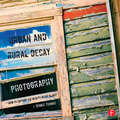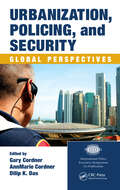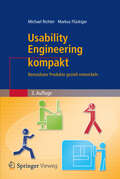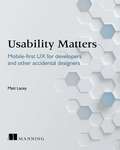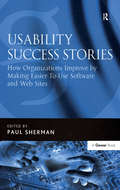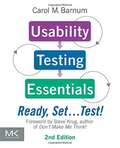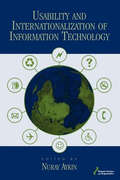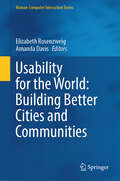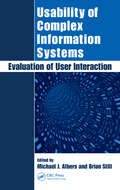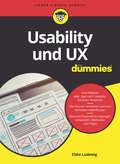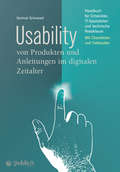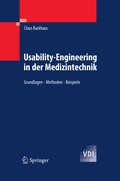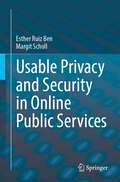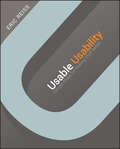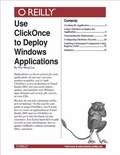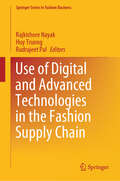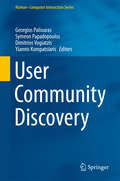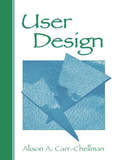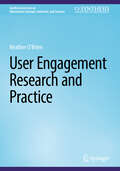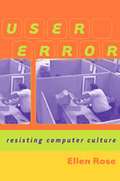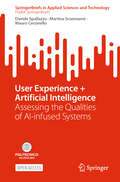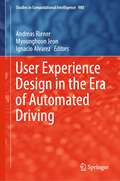- Table View
- List View
Urban and Rural Decay Photography: How to Capture the Beauty in the Blight
by J. Dennis ThomasIf you are a photographer who sees the beauty in abandoned buildings, crumbling facades, and preserving a fading history, and who also has a love of urban exploration, you have stumbled on a must-have for your photographic library. Urban and Rural Decay Photography offers expert tips and techniques for capturing breathtaking photographs of your favorite decay scenes, whether in urban or rural settings. Author J. Dennis Thomas guides you through the history of decay photography, shows you what equipment you will need, and discusses digital, film and HDR capture and composition. The book addresses which artistic considerations work best for the kinds of shots that capture a moment and convey a story. He also provides you with important safety advice and matters of the law when entering and working with decaying structures. Chock full of inspiring images that will ignite your creativity and your passion for decay photography, Urban and Rural Decay Photography is just the book you need to get you out and discovering your newest urban or rural exploration adventure.
Urbanization, Policing, and Security: Global Perspectives (International Police Executive Symposium Co-Publications)
by Gary Cordner Dilip K. Das AnnMarie CordnerIn terms of raw numbers, the amount of world urban dwellers have increased four-fold, skyrocketing from 740 million in 1950 to almost 3.3 billion in 2007. This ongoing urbanization will continue to create major security challenges in most countries. Based on contributions from academics and practitioners from countries as diverse as Nigeria, Pakist
Usability Engineering kompakt
by Markus D. Flückiger Michael RichterUsability Engineering spielt überall dort eine Rolle, wo Benutzer mit technischen Systemen zu tun haben. Welche Faktoren bestimmen, ob wir mit einem Produkt sehr einfach, nur schwer oder gar nicht zum Ziel kommen? Welche Möglichkeiten bieten sich, diese Faktoren in der Entwicklung systematisch in den Griff zu bekommen? Dieses Buch vermittelt einen leicht verständlichen Einstieg in die Praxis und bietet Ihnen das Wichtigste übersichtlich zum Nachschlagen: Die wichtigsten MethodenUmsetzung im EntwicklungsprozessUsability und Requirements EngineeringStrategie im UnternehmenPlanung, Durchführung und KontrolleChecklisten, Praxisbeispiele, DenkanstößeFallstudien aus durchgeführten Projekten Die dritte Auflage wurde durchgehend überarbeitet und um die Themen Agile Software-Entwicklung und Mobile User Experience erweitert.
Usability Matters: Mobile-first UX for developers and other accidental designers
by Matt LaceySummaryUsability Matters: Mobile-first UX for developers and other accidental designers gives you practical advice and guidance on how to create attractive, elegant, and useful user interfaces for native and web-based mobile apps. Purchase of the print book includes a free eBook in PDF, Kindle, and ePub formats from Manning Publications.About the TechnologyJust because a mobile app works doesn't mean real people are going to like it. Usability matters! Most mobile developers wind up being part-time designers, and mastering a few core principles of mobile UI can make the difference between app and crap. About the BookUsability Matters is a guide for developers wrestling with the subtle art of mobile design. With each expertly presented example, app developer and designer Matt Lacey provides easy-to-implement techniques that instantly boost your design IQ. Skipping highbrow design theory, he addresses topics like gracefully handling network dropouts and creating intuitive data inputs. Read this book and your apps will look better, your users will be happier, and you might even get some high-fives at the next design review. What's InsideUnderstanding your users Optimizing input and output Creating fast, responsive experiences Coping with poor network conditions Managing power and resources About the ReaderThis book is for mobile developers working on native or web-based apps. About the AuthorMatt Lacey is an independent mobile developer and consultant and a Microsoft MVP. He's built, advised on, and contributed to apps for social networks, film and TV broadcasters, travel companies, banks and financial institutions, sports companies, news organizations, music-streaming services, device manufacturers, and electronics retailers. These apps have an installed base of more than 500,000,000 users and are used every day around the world.Matt previously worked at a broad range of companies, doing many types of development. He has worked at startups, small ISVs, national enterprises, and global consultancies, and written software for servers, desktops, devices, and industrial hardware in more languages than he can remember. He lives in the UK with his wife and two children. Table of Contents IntroductionPart 1 - ContextWho's using the app?Where and when is the app used?What device is the app running on?Part 2- InputHow people interact with the appUser-entered dataData not from a userPart 3 - OutputDisplaying items in the appNon-visible outputPart 4 - ResponsivenessUnderstanding the perception of timeMaking your app start fastMaking your app run fastPart 5 - ConnectivityCoping with varying network conditionsManaging power and resources
Usability Success Stories: How Organizations Improve By Making Easier-To-Use Software and Web Sites
by Paul ShermanPeople spend increasing amounts of time and effort interacting with complex hardware and software products. Some of the products we interact with are easy to learn and easy to remember. Some are even a pleasure to use. Others are hard to learn, hard to use, and frustrate us at every turn. But it is not just the user that pays the cost in such cases. Poor usability also imposes significant costs on product producers. Companies that make hard-to-use products incur higher support costs, spend more on rework, and have less satisfied customers. These outcomes can be avoided by applying the techniques of usability engineering and user-centred design (UCD) during product development. This book shows how usability and UCD practitioners do this by studying users' needs and abilities, designing the product accordingly, and verifying the design through additional testing with users. Despite the positive return on investment for usability engineering activities, many organizations view usability engineering as a non-critical part of the product development process. This book seeks to change this by relating a number of cases where usability engineering contributed significantly to the solution of a business problem. Evidence is drawn from experiences within a range of private and public sector organizations showing how usability work can best be organized and executed within a business environment. The organizational factors that facilitate or impede the application of usability engineering are also discussed. The book clearly explains the barriers to be overcome as well as highlighting the factors promoting success. A wide range of applications are covered, including web-based e-commerce, medical devices and software, process control management systems, financial services applications, consumer desktop applications and interactive voice response systems. Usability Success Stories provides a valuable guide for business managers and technical staff as well as for practitioners within the field itself.
Usability Testing Essentials: Ready, Set ...Test!: Ready, Set...Test!
by Carol M. BarnumUsability Testing Essentials presents a practical, step-by-step approach to learning the entire process of planning and conducting a usability test. It explains how to analyze and apply the results and what to do when confronted with budgetary and time restrictions. This is the ideal book for anyone involved in usability or user-centered design―from students to seasoned professionals. Filled with new examples and case studies, Usability Testing Essentials, Second Edition is completely updated to reflect the latest approaches, tools and techniques needed to begin usability testing or to advance in this area. Provides a comprehensive, step-by-step guide to usability testing, a crucial part of every product’s development Discusses important usability issues such as international testing, persona creation, remote testing, and accessibility Presents new examples covering mobile devices and apps, websites, web applications, software, and more Includes strategies for using tools for moderated and unmoderated testing, expanded content on task analysis, and on analyzing and reporting results
Usability and Internationalization of Information Technology (Human Factors and Ergonomics)
by Nuray AykinToday, more and more Web sites are providing content in multiple languages for targeted countries, and more and more products are being designed for cultural differences in mind. However, the concept of cross-cultural design has not yet become a strong force in the practitioners' and educators' agenda. This book looks at techniques, software, tools
Usability for the World: Building Better Cities and Communities (Human–Computer Interaction Series)
by Amanda Davis Elizabeth RosenzweigWant to build cities that truly work for everyone? Usability for the World: Sustainable Cities and Communities reveals how human-centered design is key to thriving, equitable urban spaces. This isn't just another urban planning book; it's a practical guide to transforming cities, offering concrete strategies and real-world examples you can use today. What if our cities could be both efficient and human-friendly? This book tackles the core challenge of modern urban development: balancing functionality with the well-being of residents. It explores the crucial connection between usability and sustainability, demonstrating how design principles, from Universal to life-centered, create truly livable cities. Interested in sustainable urban development? Usability for the World offers a global perspective, showcasing diverse approaches to creating equitable and resilient cities. Through compelling case studies, discover how user-centered design addresses pressing urban challenges. See how these principles connect directly to achieving the UN Sustainable Development Goals, specifically SDG 11: Sustainable Cities and Communities. This book offers more than theory. It provides practical insights and actionable strategies for: Designing user-centered cities: Apply usability principles to urban planning. Improving urban spaces: Discover how tech and innovation create human-friendly environments. Building sustainable communities: Explore the link between human-centered design and the SDGs. Creating equitable cities: Understand how design promotes inclusivity and accessibility. Whether you're an urban planner, designer, policymaker, or simply someone who cares about our cities' future, Usability for the World provides the tools and inspiration you need. Join the movement to build better cities, one human-centered design at a time. What will your contribution be to the future of urban living?
Usability of Complex Information Systems: Evaluation of User Interaction
by Michael J. Albers Brian StillWhy do enterprise systems have complicated search pages, when Google has a single search box that works better? Why struggle with an expense reimbursement system that is not as easy as home accounting software? Although this seems like comparing apples to oranges, as information and communication technologies increasingly reach into every industry
Usability und UX für Dummies (Für Dummies)
by Elske LudewigSie erstellen eine Website und wissen nicht, wie Sie sie sinnvoll aufbauen und designen? Sie möchten Ihre Kunden länger auf Ihrer Website halten? Sie träumen davon, dass mehr Kunden den Kaufen-Button klicken? Steigen Sie mit diesem Buch in das Thema "Benutzerfreundlichkeit" und "Positives Nutzererlebnis" ein. Führen Sie Ihre Kunden schnell und einfach zu ihrem Ziel, vermitteln Sie ihnen ein positives Gefühl und machen Sie ihnen die Kaufentscheidung leicht. Fangen Sie bei der Lesbarkeit der Texte an, achten Sie auf die Auffindbarkeit wichtiger Funktionen und lernen Sie, wie man benutzerfreundliche Formulare entwickelt. Was bei mobilen Websites und Apps anders ist, erfahren Sie natürlich auch.
Usability von Produkten und Anleitungen im digitalen Zeitalter: Handbuch für Entwickler, IT-Spezialisten und technische Redakteure
by Gertrud GrünwiedTechnische Produkte können nur erfolgreich sein, wenn die Gebrauchstauglichkeit, die Usability, frühzeitig im Entwicklungsprozess geplant und in allen Produktphasen verankert wird. Dies betrifft smarte Geräte, Softwareprodukte, Webanwendungen und Apps genauso wie komplexe und umfangreich dokumentierte Maschinen, Fahrzeuge und Systeme. In ihrem Buch vermittelt Gertrud Grünwied eine ganzheitliche Sicht auf intuitiv bedienbare Produkte und deren Anleitungen. Sie bietet das relevante Know-how zu User-Centered Design und eine Übersicht zur Auswahl von Usability-Methoden. Usability-Maßnahmen beschreibt sie schrittweise von der Planung, der Durchführung und Auswertung bis zur Optimierung von Produkt und Anleitung. Der Praxisteil präsentiert Fallstudien für Anleitungen mit und ohne Produkt sowie für eine Dienste-App im Internet, außerdem eine Betrachtung zu Kosten, Nutzen und Implementierungszeitpunkt von Usability-Methoden. Die dargestellten Usability-Maßnahmen erstrecken sich nicht nur auf das technische Produkt selbst, sondern auch auf die Nutzungssituation und die smarte Benutzerinformation, zum Beispiel das Nachschlagen in der Bedienungsanleitung zur Fehlerbehebung, Dokumentations-Apps zum Kennenlernen von Systemfunktionen oder das Üben und Lernen anhand einer Produktsimulation per Video-Tutorial oder Animation. Damit richtet sich das Buch an alle Mitarbeiter produzierender Unternehmen und ihrer Dienstleister, die an Usability-Aspekten beteiligt sind - Produktmanager, Entwickler, IT-Spezialisten, Designer, Technische Redakteure und Mitarbeiter in Schulung und Service, aber auch an Studierende der Informatik und Ingenieurwissenschaften einschließlich Technischer Redaktion und Kommunikation. Inhalt: Anforderungen an Usability von Produkten und Anleitungen "4.0" - Prozesse und Planung - Nutzer- und Nutzungsforschung - Gestaltung - Evaluation - Anwenden der Methoden und ihre Wirtschaftlichkeit - Fallstudien - Software-Tools und Normen
Usability-Engineering in der Medizintechnik
by Claus BackhausErgonomisch gestaltete Medizintechnik führt zu effizienteren Arbeitsabläufen, erhöht die Patientensicherheit und reduziert die Arbeitsbelastung. Das Buch erläutert, wie Medizintechnik an die Bedürfnisse der Nutzer und Anwender angepasst werden kann. Durch das beschriebene Vorgehen ist es möglich, sowohl die Anforderungen der harmonisierten Normen DIN EN 62366 und DIN EN 60601-1-6 umzusetzen als auch neue Lösungsansätze für die Entwicklung innovativer Medizintechnik zu erarbeiten. Die Umsetzung wird anhand ausgewählter Praxisbeispiele erörtert.
Usable Privacy and Security in Online Public Services
by Esther Ruiz Ben Margit SchollThis practice-oriented book is a unique guide to the implementation of usable, privacy-compliant and secure online services in the area of e-government. Beginning with a clarification of basic concepts of usability, data privacy, and cybersecurity, the book provides lucid explanations of different methods (quantitative, qualitative, and mixed methods) that can be applied in the practice of designing, developing, and evaluating online public services in light of both usability criteria and data privacy and IT security compliance. A number of examples and exercises are included as well as awareness-raising measures that can serve as orientation both for practitioners and for teaching purposes. There is also a concise glossary of terms along with recommendations for further reading.This book provides comprehensive coverage of usability, data privacy and information security topics. At the time of going to press, it is also up to date with respect to the implementation of the EU Single Digital Gateway regulation. It is therefore aimed at anyone interested in understanding the principles of usable privacy and information security and in ways of contributing to the design, development, and evaluation of online public services that satisfy the needs of the public. The book’s audience thus includes not only students in the areas of e-government or public administration but also professionals developing online services or e-government applications.
Usable Usability: Simple Steps for Making Stuff Better
by Eric ReissThe A-to-Z guide to spotting and fixing usability problems Frustrated by pop-ups? Forms that make you start over if you miss a field? Nonsensical error messages? You're not alone! This book helps you simply get it right the first time (or fix what's broken). Boasting a full-color interior packed with design and layout examples, this book teaches you how to understand a user's needs, divulges techniques for exceeding a user's expectations, and provides a host of hard won advice for improving the overall quality of a user's experience. World-renowned UX guru Eric Reiss shares his knowledge from decades of experience making products useable for everyone...all in an engaging, easy-to-apply manner. Reveals proven tools that simply make products better, from the users' perspective Provides simple guidelines and checklists to help you evaluate and improve your own products Zeroes in on essential elements to consider when planning a product, such as its functionality and responsiveness, whether or not it is ergonomic, making it foolproof, and more Addresses considerations for product clarity, including its visibility, understandability, logicalness, consistency, and predictability Usable Usability walks you through numerous techniques that will help ensure happy customers and successful products!
Usando o Snapchat: Guia para o Aplicativo, Filtros, Emojis, Lentes, Fontes, Streaks & Muito Mais!
by Ken Rogers André RodriguesUm guia passo a passo sobre como usar e dominar o Snapchat. Aprenda a enviar mensagens, usar bitmojis, editar snaps, criar stories, transferir dinheiro e muito mais!
Use ClickOnce to Deploy Windows Applications
by Wei-Meng LeeClickOnce, a new technology in Visual Studio 2005, lets you quickly and easily deploy your Windows apps via web servers, file servers, or even CDs. But while ClickOnce delivers web-style deployment of your application, that's only part of the story. Once you've installed an application using ClickOnce, it can automatically check for new updates to the application, which saves time in application maintenance and upgrades. And on the security front, a ClickOnce application runs within a secure sandbox and you configure it using the Code Access Security model. So, how can you take advantage of this new technology? In this step-by-step guide to using ClickOnce, you'll learn how to create an application in Visual Studio 2005 and how to use ClickOnce to quickly get it in the hands of your customers. You'll also learn how to add security to your distributions using Code Access Security; how to update COM files without corrupting DLLs; and more.
Use of Digital and Advanced Technologies in the Fashion Supply Chain (Springer Series in Fashion Business)
by Rajkishore Nayak Huy Truong Rudrajeet PalThis book explores the integration of innovative technologies in the fashion industry to enhance efficiency, sustainability, and customer experience. It provides an in-depth analysis of the various advanced technologies, such as data analytics, 3D printing, robotics, blockchain, RFID, IOT, and artificial intelligence, and how they can be applied in the fashion supply chain. The book also examines the opportunities and challenges that arise with the adoption of these technologies in different areas of the fashion industry, from design and production to marketing and sales. Overall, the book presents a comprehensive overview of the impact of digital and advanced technologies on the fashion supply chain and how these technologies can drive the industry towards a more sustainable and customer-centric future.
User Community Discovery
by Georgios Paliouras Symeon Papadopoulos Dimitrios Vogiatzis Yiannis KompatsiarisThis book redefines community discovery in the new world of Online Social Networks and Web 2. 0 applications, through real-world problems and applications in the context of the Web, pointing out the current and future challenges of the field. Particular emphasis is placed on the issues of community representation, efficiency and scalability, detection of communities in hypergraphs, such as multi-mode and multi-relational networks, characterization of social media communities and online privacy aspects of online communities. User Community Discovery is for computer scientists, data scientists, social scientists and complex systems researchers, as well as students within these disciplines, while the connections to real-world problem settings and applications makes the book appealing for engineers and practitioners in the industry, in particular those interested in the highly attractive fields of data science and big data analytics.
User Design
by Alison A. Carr-ChellmanUser Design offers a fresh perspective on how front-line learners (users) can participate in the design of learning environments. The author challenges the universal assumption that front-line users must be relegated to the role of offering input, and that the actual design activity of learning systems must still be conducted only by experts. The b
User Engagement Research and Practice (Synthesis Lectures on Information Concepts, Retrieval, and Services)
by Heather O'BrienThis book presents a holistic overview of user engagement, which has become an increasingly important subject for a variety of industry and academic fields, including engineering, computer science, and information science. The author begins with a definition of user engagement and an explanation of the theoretical background of the topic. The book then covers methodological approaches and examines some of the broader factors that influence user engagement. The author explains methods for measuring user engagement and evaluates the efficacy of each one. The book includes examples from recent research studies throughout, describing user engagement in different settings with a variety of digital information systems.
User Error: Resisting Computer Culture
by Ellen RoseUser Error explodes the myth of computer technology as juggernaut. Multimedia educator Ellen Rose shows that there is no bandwagon, no out-of-control dynamo, no titanic conspiracy to overwhelm us. Instead, there is our own desire to join the fraternity of users, a fraternity that confers legitimacy and power on those who enter the brave new world. Rose exposes how we surrender decision-making power in personal and workplace computing situations. As users we willingly grant authority to the creators of software, support materials, and the seductive infrastructure of technocracy. “Smart” users are rewarded; reluctant users are pathologized. User identity is deliberately constructed at the crossroads of industry, consumer demand, and complicity. User Error sounds a timely alarm, calling on all of us who use the new technologies to recognize how we are being co-opted. With awareness we can reassert our own responsibility and power in this increasingly important interaction. Savvy, accessible, and up-to-date, User Error offers insight, inspiration, and strategies of resistance to general readers, technology professionals, students, and scholars alike.
User Experience + Artificial Intelligence: Assessing the Qualities of AI-infused Systems (SpringerBriefs in Applied Sciences and Technology)
by Davide Spallazzo Martina Sciannamè Mauro CeconelloThis open access book addresses the thriving trend of embedding artificial intelligence (AI) and machine learning (ML) capabilities in products and services reaching the lay public, focusing on the user experience (UX) they prompt from a designerly perspective. It offers a UX evaluation method designed explicitly for AI-infused systems to answer one of the core problems affecting the relationship and interactions people have with such artefacts. The work investigates how people perceive and make sense of systems integrating AI capabilities, trying to understand how their meaning and significance can affect the experience of such products and what design challenges may arise. Given the fundamental premise that current UX methods cannot address AI-infused artefacts, it introduces the results of Meet-AI, a research project exploring specific ways to tackle these problems. The book then presents a comprehensive analysis of current UX methods, and a literature review focused on detecting possible gaps and the most suitable qualities to describe AI-infused systems, and summarizes the findings from all previous investigations into a UX evaluation scale: AIXE (AI user eXperience Evaluation). The book also portrays how the tool has been validated and expanded to become a more comprehensive method. It further describes how the scale has been applied to a comparative study of domestic smart speakers, and introduces a reversed interpretation of the outcomes, framing them as heuristics to inform the early phases of the design process and paving the way for future experimentations in the meta-design dimension.
User Experience Design in the Era of Automated Driving (Studies in Computational Intelligence #980)
by Andreas Riener Myounghoon Jeon Ignacio AlvarezThis book is dedicated to user experience design for automated driving to address humane aspects of automated driving, e.g., workload, safety, trust, ethics, and acceptance. Automated driving has experienced a major development boost in recent years. However, most of the research and implementation has been technology-driven, rather than human-centered. The levels of automated driving have been poorly defined and inconsistently used. A variety of application scenarios and restrictions has been ambiguous. Also, it deals with human factors, design practices and methods, as well as applications, such as multimodal infotainment, virtual reality, augmented reality, and interactions in and outside users. This book aims at 1) providing engineers, designers, and practitioners with a broad overview of the state-of-the-art user experience research in automated driving to speed-up the implementation of automated vehicles and 2) helping researchers and students benefit from various perspectives and approaches to generate new research ideas and conduct more integrated research.
User Experience Design: An Introduction to Creating Interactive Digital Spaces
by Mark Wells'A great introduction to the subject and a fascinating read.'- James Friedlander-Boss, Brand Experience Manager, vvastWe all engage with digital user experience design and user interfaces every day - if you are reading this on an e-commerce platform then you are doing it right now. This is an invaluable introduction for designers and creatives on how to create successful digital environments for users.The discipline of graphic design is increasingly carried out in the virtual sphere, with a greater emphasis on user interaction and user experience than ever before. This book takes students through the crucial stages and skills that are needed for creating successful interactive digital environments, including:- Data collection- User analysis - Testing- Creating valid content- Design for different devices and platforms- Prototyping and visualizationVisual examples range from screen shots to diagrams and physical prototypes, while case studies featuring digital agencies and creatives from around the world show how they approach each project.
User Experience Design: An Introduction to Creating Interactive Digital Spaces
by Mark Wells'A great introduction to the subject and a fascinating read.'- James Friedlander-Boss, Brand Experience Manager, vvastWe all engage with digital user experience design and user interfaces every day - if you are reading this on an e-commerce platform then you are doing it right now. This is an invaluable introduction for designers and creatives on how to create successful digital environments for users.The discipline of graphic design is increasingly carried out in the virtual sphere, with a greater emphasis on user interaction and user experience than ever before. This book takes students through the crucial stages and skills that are needed for creating successful interactive digital environments, including:- Data collection- User analysis - Testing- Creating valid content- Design for different devices and platforms- Prototyping and visualizationVisual examples range from screen shots to diagrams and physical prototypes, while case studies featuring digital agencies and creatives from around the world show how they approach each project.
